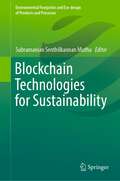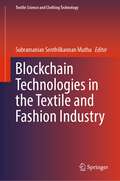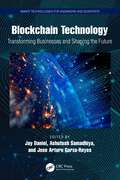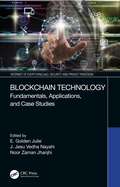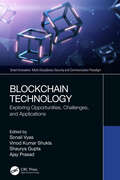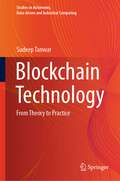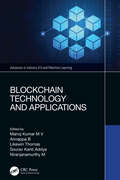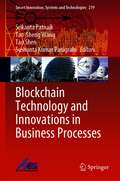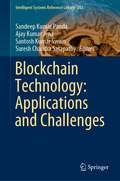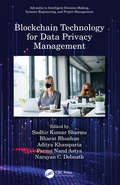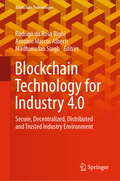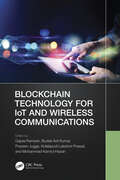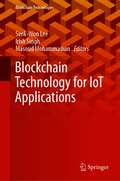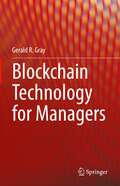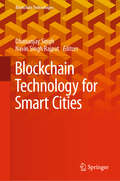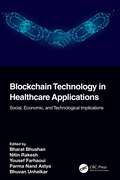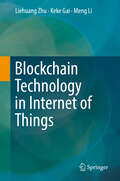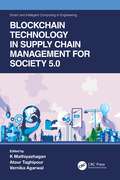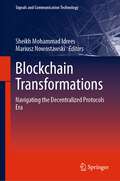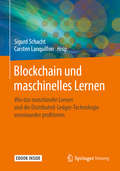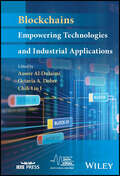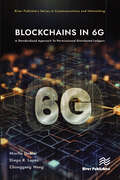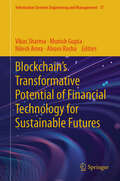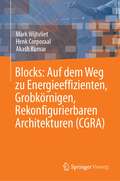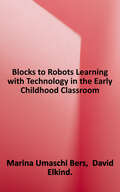- Table View
- List View
Blockchain Technologies for Sustainability (Environmental Footprints and Eco-design of Products and Processes)
by Subramanian Senthilkannan MuthuThis book highlights the applications of blockchain technologies to foster sustainable development in different fields. The concept of Sustainability has grown widespread in today’s context and there are many requirements to achieve Sustainability in any industrial sector including mapping, tracing the supply chain to ensure sustainable supply chain management. Reliable and transparent, efficient data is one of the key requirements for Sustainability in today’s advanced industrial context. Achievement of Sustainability objectives in this advanced era demands various technological advancements such as Blockchain technologies. The core competencies of blockchain technology namely transparency, data auditability, privacy, value transfer, and process efficiency and automation are very much essential for achieving the multifold objectives under sustainability.
Blockchain Technologies in the Textile and Fashion Industry (Textile Science and Clothing Technology)
by Subramanian Senthilkannan MuthuThis book presents applications of blockchain technologies to foster sustainable development in the textile and clothing supply chain. The concept of Textiles and Fashion Sustainability has grown to a wider extent today. Among the list of items to achieve Sustainability in Textiles and Fashion, the key element is the traceability of supply chains in terms of mapping and tracing the entire supply chain to ensure sustainable supply chain management. Reliable and transparent, efficient data is one of the crucial requirements for Textiles and Fashion Sustainability in today’s advanced industrial context and this is possible in this advanced era by various technological advancements such as Block chain technologies. These days one can see a widespread application of blockchain technology in the Textiles and Clothing sector. The core competencies of blockchain technology namely transparency, data auditability, privacy, value transfer, and process efficiency and automation are very much essential for achieving the multifold objectives under the theme Textiles and Fashion Sustainability.
Blockchain Technology: Transforming Businesses and Shaping the Future (Smart Technologies for Engineers and Scientists)
by Jay Daniel Ashutosh Samadhiya Arturo Garza-Reyes, JoseBlockchain technology is considered a disruptive innovation that changes the ways companies and global processes operate. This technology has impressive powers to change this world for the better.This book examines the origins, emergence, challenges, and opportunities in the blockchain field, rethinking business strategy and readiness in the digital world and how blockchain technology would improve businesses. It provides a blockchain readiness model for managing supply chains and reviews enabling technologies such as AI, big data and organisational capabilities that support the adoption of blockchain technology. Through innovative design and simulation of a blockchain framework, it aims to enhance the traceability and transparency of business operations and supply chains. This includes developing key performance indicators for measuring the seamless integration of blockchain technology and achieving a successful outcome. It explores how blockchain technology enhances the green and sustainability aspects of businesses by comparing the sectors and discussing the potential for blockchain to promote a green and sustainable economy. This book concludes with research frontiers and blockchain applications in healthcare, international trade, and supply chain sectors.Key features Integrates both theoretical and practical perspectives Includes material that is informative for readers from diverse backgrounds and disciplines Explores blockchain technology practices and challenges in-depth across various sectors Offers up-to-date, critical insights on the design, management, and control of blockchain technology for businesses Written by experts with extensive experience in the field. It is primarily written for senior undergraduate, graduate students, and academic researchers in the fields including electrical engineering, electronics and communication engineering, computer engineering, and information technology.
Blockchain Technology: Fundamentals, Applications, and Case Studies (Internet of Everything (IoE))
by E. Golden Julie, J. Jesu Vedha Nayahi, and Noor Zaman JhanjhiThis book presents a detailed exploration of adaption and implementation, as well as a 360-degree view spectrum of blockchain technologies in real-world business applications. Blockchain is gaining momentum in all sectors. This book offers a collection of protocol standards, issues, security improvements, applicability, features, and types of cryptocurrency in processing and through 5G technology. The book covers the evolution of blockchain from fundamental theories to present forms. It offers diversified business applications with usable case studies and provides successful implementations in cloud/edge computing, smart city, and IoT. The book emphasizes the advances and cutting-edge technologies along with the different tools and platforms. The primary audience for this book includes industry experts, researchers, graduates and under graduates, practitioners, and business managers who are engaged in blockchain and IoT-related technologies.
Blockchain Technology: Exploring Opportunities, Challenges, and Applications (Smart Innovation)
by Sonali Vyas, Vinod Kumar Shukla, Shaurya Gupta and Ajay PrasadThis book is for anyone who wants to gain an understanding of Blockchain technology and its potential. The book is research-oriented and covers different verticals of Blockchain technology. It discusses the characteristics and features of Blockchain, includes techniques, challenges, and future trends, along with case studies for deeper understanding. Blockchain Technology: Exploring Opportunities, Challenges, and Applications covers the core concepts related to Blockchain technology starting from scratch. The algorithms, concepts, and application areas are discussed according to current market trends and industry needs. It presents different application areas of industry and academia and discusses the characteristics and features of this technology. It also explores the challenges and future trends and provides an understanding of new opportunities. This book is for anyone at the beginner to intermediate level that wants to learn about the core concepts related to Blockchain technology.
Blockchain Technology: From Theory to Practice (Studies in Autonomic, Data-driven and Industrial Computing)
by Sudeep TanwarBlockchain is an emerging technology platform for developing decentralized applications and data storage, over and beyond its role as the technology underlying the cryptocurrencies. The basic tenet of this platform is that it allows one to create a distributed and replicated ledger of events, transactions, and data generated through various IT processes with strong cryptographic guarantees of tamper resistance, immutability, and verifiability. Public blockchain platforms allow us to guarantee these properties with overwhelming probabilities even when untrusted users are participants of distributed applications with the ability to transact on the platform. Even though, blockchain technology has become popularly known because of its use in the implementation of cryptocurrencies such as BitCoin, Ethereum, etc.; the technology itself holds much more promise in various areas such as time stamping, logging of critical events in a system, recording of transactions, trustworthy e-governance, etc. It introduces theoretical and practical aspects of blockchain technology. The book includes an in-depth insight into the need for decentralization, smart contracts, consensus both permissioned and permissionless, and various blockchain development frameworks, tools, and platforms. It can be used as a learning resource for various examinations and certifications related to cryptocurrency and blockchain technology. This book explained the nuts and bolts of blockchain technology in lucid language to make students more familiar with the implementation perspective of this much-needed technology.
Blockchain Technology and Applications (Advances in Industry 4.0 and Machine Learning)
by M V, Manoj Kumar Annappa B Likewin Thomas Sourav Kanti Addya Niranjanamurthy MBlockchain is an emerging platform for developing decentralized applications and data storage, over and beyond its role as a platform for cryptocurrencies. This reference text provides a comprehensive discussion on blockchain technology from research and application perspective. Discusses different approaches for building distributed applications (DAPPS). Provides detailed listing and discussion of blockchain technology applications in solving real life problems. Covers proof of work (PoW) based blockchain consensus, and proof of stake (PoS) based blockchain consensus. Discusses blockchain algorithms including practical byzantine fault tolerance (PBFT) and simplified byzantine fault tolerance (SBFT). It comprehensively covers important topics including blockchain consensus algorithms, Ethereum, Hyperledger, blockchain scalability, smart contracts with solidity, ERC20 standards, building DApp with Golang, building DApp using Hyperledger, building PoCs with Hyperledger fabric, blockchain as a server, blockchain security and privacy. The text will serve as a useful text for senior undergraduate and graduate students in interdisciplinary areas including electronics and communications engineering, electrical engineering, computer science, and information technology.
Blockchain Technology and Innovations in Business Processes (Smart Innovation, Systems and Technologies #219)
by Srikanta Patnaik Tao-Sheng Wang Tao Shen Sushanta Kumar PanigrahiThis edited book provides a platform to bring together researchers, academia and industry collaborators to exchange their knowledge and work to develop better understanding about the scope of blockchain technology in business management applications of different sectors such as retail sector, supply chain and logistics, healthcare sector, manufacturing sector, judiciary, finance and government sector in terms of data quality and timeliness. The book presents original unpublished research papers on blockchain technology and business management on novel architectures, prototypes and case studies.
Blockchain Technology: Applications and Challenges (Intelligent Systems Reference Library #203)
by Sandeep Kumar Panda Ajay Kumar Jena Santosh Kumar Swain Suresh Chandra SatapathyThis book discusses the various open issues of blockchain technology, such as the efficiency of blockchain in different domains of digital cryptocurrency, smart contracts, smart education system, smart cities, cloud identity and access, safeguard to cybersecurity and health care. For the first time in human history, people across the world can trust each other and transact over a large peer-to-peer networks without any central authority. This proves that, trust can be built not only by centralized institution but also by protocols and cryptographic mechanisms. The potential and collaboration between organizations and individuals within peer networks make it possible to potentially move to a global collaborative network without centralization. Blockchain is a complex social, economic and technological phenomenon. This questions what the established terminologies of the modern world like currency, trust, economics and exchange would mean. To make any sense, one needs to realize how much insightful and potential it is in the context and the way it is technically developed. Due to rapid changes in accessing the documents through online transactions and transferring the currency online, many previously used methods are proving insufficient and not secure to solve the problem which arises in the safe and hassle-free transaction. Nowadays, the world changes rapidly, and a transition flow is also seen in Business Process Management (BPM). The traditional Business Process Management holds good establishment last one to two decades, but, the internal workflow confined in a single organization. They do not manage the workflow process and information across organizations. If they do so, again fall in the same trap as the control transfers to the third party that is centralized server and it leads to tampering the data, and single point of failure. To address these issues, this book highlights a number of unique problems and effective solutions that reflects the state-of-the art in blockchain Technology. This book explores new experiments and yields promising solutions to the current challenges of blockchain technology. This book is intended for the researchers, academicians, faculties, scientists, blockchain specialists, business management and software industry professionals who will find it beneficial for their research work and set new ideas in the field of blockchain. This book caters research work in many fields of blockchain engineering, and it provides an in-depth knowledge of the fields covered.
Blockchain Technology for Data Privacy Management (Advances in Intelligent Decision-Making, Systems Engineering, and Project Management)
by Sudhir Kumar Sharma Bharat Bhushan Aditya Khamparia Parma Nand Astya Narayan C. DebnathThe book aims to showcase the basics of both IoT and Blockchain for beginners as well as their integration and challenge discussions for existing practitioner. It aims to develop understanding of the role of blockchain in fostering security. The objective of this book is to initiate conversations among technologists, engineers, scientists, and clinicians to synergize their efforts in producing low-cost, high-performance, highly efficient, deployable IoT systems. It presents a stepwise discussion, exhaustive literature survey, rigorous experimental analysis and discussions to demonstrate the usage of blockchain technology for securing communications. The book evaluates, investigate, analyze and outline a set of security challenges that needs to be addressed in the near future. The book is designed to be the first reference choice at research and development centers, academic institutions, university libraries and any institutions interested in exploring blockchain. UG/PG students, PhD Scholars of this fields, industry technologists, young entrepreneurs and researchers working in the field of blockchain technology are the primary audience of this book.
Blockchain Technology for Industry 4.0: Secure, Decentralized, Distributed and Trusted Industry Environment (Blockchain Technologies)
by Rodrigo da Rosa Righi Antonio Marcos Alberti Madhusudan SinghThis book explores recent advances in blockchain technology and its impact on Industry 4.0 via advanced technologies. It provides an in-depth analysis of the step by step evolution of Industry 4.0 and blockchain technologies for creating the next-generation, secure, decentralized, distributed and trusted industry environment and enhancing the productivity of industries. The book describes how blockchain technology makes the industrial internet (Industry 4.0) a transparent, reliable and secure environment for people, processes, systems, and services, presenting a strong, technological and conceptual framework and roadmap for decision-makers involved in the transformation of any area of industry.
Blockchain Technology for IoT and Wireless Communications
by Gajula Ramesh Budati Anil Kumar Praveen Jugge Kolalapudi Lakshmi Prasad Mohammad Kamrul HasanSmart communications are the concept in which smart appliances and devices are integrated into an application that runs in a smart hand-held device. The residents of a smart home can have complete control over their home’s electronic gadgets using wireless communications. These technologies can help people control gadgets in the home/office remotely and often simultaneously, which increases convenience and reduces time spent on these tasks. However, problems can arise in the security systems associated with these smart devices; security may be compromised when there are loopholes or human mistakes. When security credentials are lost, overall security can also be lost. This is because smart technology is made up of plenty of devices that are integrated with Internet of Things (IoT) technology and the cloud. This environment can introduce many security issues, as discussed in this text. Blockchain is a promising technology that operates in a decentralized environment to protect devices and the data collected by devices from security and privacy issues by using wireless communication technology. Blockchain-enabled IoT can be used to achieve end-to-end security. Blockchain technology is already used in wireless sensor/communication networks to estimate and predict house data and civil structures. IoT-integrated innovative applications like smart homes present unique security and privacy challenges. Scalability is the main problem as the current centralized IoT platforms have message routing mechanisms that create a bottleneck in scaling up too many devices used in IoT. As many devices are participating in generating data, such a setup may also be subjected to Distributed Denial of Service (DDoS) attacks. Lack of data standards is another cause of concern as it leads to interoperability problems. Blockchain technology for IoT and wireless communications offers a promising solution for smart devices. These technologies can provide end-to-end security and overcome the aforementioned problems. The usage of open-standard distributed IoT solutions can solve many problems that are associated with centralized approaches. Blockchain technology is nothing but a distributed ledger of transactions. It offers direct communication to connected devices. Such devices collect data, and all legitimate participants can access said data. Thus, decentralized blockchain networks can provide improved security for IoT-based solutions.
Blockchain Technology for IoT Applications (Blockchain Technologies)
by Seok-Won Lee Irish Singh Masoud MohammadianThis book explores recent advances in the Internet of things (IoT) via advanced technologies and provides an overview of most aspects which are relevant for advance secure, distributed, decentralized blockchain technology in the Internet of things, their applications, and industry IoT. The book provides an in-depth analysis of the step-by-step evolution of IoT to create a change by enhancing the productivity of industries. It introduces how connected things, data, and their communication (data sharing) environment build a transparent, reliable, secure environment for people, processes, systems, and services with the help of blockchain technology.
Blockchain Technology for Managers
by Gerald R. GrayBlockchain is a technology that tends to be misunderstood by managers that need to make technology acquisition decisions. This book will provide readers with a basic understanding of blockchain and distributed ledger technology (DLT), the technologies that underpin it, and the technologies DLT is built upon. The book is purposefully not a book on how to code or explore other technical aspects of blockchain (other than the fundamentals). Rather, it provides managers with the basic understanding of the architectures and consensus algorithms, how they work, the design trade-offs of each architecture type, and what problems and use cases the core characteristics of DLT are best suited to solve ─ providing business managers with the core information they need to ask the right questions of vendors when making business value assessments and acquisition decisions.
Blockchain Technology for Smart Cities (Blockchain Technologies)
by Dhananjay Singh Navin Singh RajputThis book provides a comprehensive overview of various aspects of the development of smart cities from a secure, trusted, and reliable data transmission perspective. It presents theoretical concepts and empirical studies, as well as examples of smart city programs and their capacity to create value for citizens. The contributions offer a panorama of the most important aspects of smart city evolution and implementation within various frameworks, such as healthcare, education, and transportation. Comparing current advanced applications and best practices, the book subsequently explores how smart environments and programs could help improve the quality of life in urban spaces and promote cultural and economic development.
Blockchain Technology in Healthcare Applications: Social, Economic, and Technological Implications (Advances in Smart Healthcare Technologies)
by Bharat BhushanTremendous growth in healthcare treatment techniques and methods has led to the emergence of numerous storage and communication problems and need for security among vendors and patients. This book brings together latest applications and state-of-the-art developments in healthcare sector using Blockchain technology. It explains how blockchain can enhance security, privacy, interoperability, and data accessibility including AI with blockchains, blockchains for medical imaging to supply chain management, and centralized management/clearing houses alongside DLT. Features: Includes theoretical concepts, empirical studies and detailed overview of various aspects related to development of healthcare applications from a reliable, trusted, and secure data transmission perspective. Provide insights on business applications of Blockchain, particularly in the healthcare sector. Explores how Blockchain can solve the transparency issues in the clinical research. Discusses AI with Blockchains, ranging from medical imaging to supply chain management. Reviews benchmark testing of AI with Blockchains and its impacts upon medical uses. This book aims at researchers and graduate students in healthcare information systems, computer and electrical engineering.
Blockchain Technology in Internet of Things
by Liehuang Zhu Keke Gai Meng LiThis book focuses on picturing B-IoT techniques from a few perspectives, which are architecture, key technologies, security and privacy, service models and framework, practical use cases and more. Main contents of this book derive from most updated technical achievements or breakthroughs in the field. A number of representative IoT service offerings will be covered by this book, such as vehicular networks, document sharing system, and telehealth. Both theoretical and practical contents will be involved in this book in order to assist readers to have a comprehensive and deep understanding the mechanism of using blockchain for powering up IoT systems. The blockchain-enabled Internet of Things (B-IoT) is deemed to be a novel technical alternative that provides network-based services with additional functionalities, benefits, and implementations in terms of decentralization, immutability, and auditability. Towards the enhanced secure and privacy-preserving Internet of Things (IoT), this book introduces a few significant aspects of B-IoT, which includes fundamental knowledge of both blockchain and IoT, state-of-the-art reviews of B-IoT applications, crucial components in the B-IoT system and the model design, and future development potentials and trends.IoT technologies and services, e.g. cloud data storage technologies and vehicular services, play important roles in wireless technology developments. On the other side, blockchain technologies are being adopted in a variety of academic societies and professional realms due to its promising characteristics. It is observable that the research and development on integrating these two technologies will provide critical thinking and solid references for contemporary and future network-relevant solutions. This book targets researchers and advanced level students in computer science, who are focused on cryptography, cloud computing and internet of things, as well as electrical engineering students and researchers focused on vehicular networks and more. Professionals working in these fields will also find this book to be a valuable resource.
Blockchain Technology in Supply Chain Management for Society 5.0 (Smart and Intelligent Computing in Engineering)
by K Mathiyazhagan Atour Taghipour Vernika AgarwalSociety 5.0 is a human-centered community where integrated systems operate throughout society to secure comfort in all aspects of life, from energy and medical care, to education, work, and leisure. Blockchain technologies enable the streamlining of supply chain processes and information sharing among various industries. This book presents recent research on the adaptation and implementation of Blockchain technologies in supply chain management in Society 5.0. It discusses different applications of blockchain, its important role in connecting information technology and artificial intelligence with human lives, the challenges, and the future of supply chain management for societal improvements.
Blockchain Transformations: Navigating the Decentralized Protocols Era (Signals and Communication Technology)
by Sheikh Mohammad Idrees Mariusz NowostawskiThis book provides a guide for those looking to understand the potential of blockchain technology and its impact on various industries. The book provides an in-depth exploration of blockchain technology, its use cases, and the opportunities and challenges it presents. From digital currencies and smart contracts to supply chain management and decentralized finance, the book covers all the key aspects of blockchain technology. The authors also go beyond the technical details, providing valuable insights and practical advice on how to navigate this new era of decentralization and trustless transactions. The book is an ideal read for researchers, entrepreneurs, investors, or anyone looking to stay ahead of the curve and stay informed about the future of blockchain technology.
Blockchain und maschinelles Lernen: Wie das maschinelle Lernen und die Distributed-Ledger-Technologie voneinander profitieren
by Sigurd Schacht Carsten LanquillonDurch Bitcoin wurde die Blockchain als zugrundeliegende Technologie bekannt. Sie zählt zu den Distributed-Ledger-Technologien, die zukünftig viele Bereiche des wirtschaftlichen Handels beeinflussen werden. So bergen dezentrale autonome Anwendungen enormes Potenzial, nicht nur Prozesse, sondern auch Vertragsabstimmungen zu automatisieren. Beispielsweise kann ein automatisiertes wirtschaftliches Handeln zwischen Maschinen ermöglicht werden. Um einen derart hohen Automatisierungsgrad zu erreichen, müssen datenbasierte Entscheidungen autonom – ohne menschliches Zutun – getroffen werden. Maschinelle Lernverfahren können dabei eine zentrale Komponente bei der Entscheidungsfindung einnehmen. Das Buch stellt erstmalig die komplementären Themengebiete Distributed-Ledger-Technologie und maschinelles Lernen gegenüber und zeigt auf, welches Potenzial freigesetzt werden kann, wenn beide Technologien zielführend miteinander verbunden werden. Das Buch ist eine unverzichtbare Lektüre für diejenigen, die sich tiefgreifendes Wissen in der Kombination beider Themengebiete aufbauen wollen, indem einerseits die theoretischen Grundlagen und andererseits auch mögliche Anwendungsszenarien dargestellt werden.
Blockchains: Empowering Technologies and Industrial Applications (IEEE Series on Digital & Mobile Communication)
by Anwer Al-Dulaimi Octavia A. Dobre Chih-Lin IBlockchains Empowering Technologies and Industrial Applications A comprehensive guide to the most recent developments in blockchains in theoretical and industrial perspectives Originally introduced as a method to keep track of Bitcoin transactions over a peer-to-peer network, blockchain is a continuously growing list of records, called blocks, which are linked and secured using cryptography into a chain held in public databases. The use of this technology has grown since its cryptocurrency creation and now store three types of information: 1) transactions, including the date, time, and value of purchases; 2) records of participates in transactions; and 3) unique code known as a “hash” that distinguishes one block from another. A single block on the blockchain can hold 1 MB of data, or potentially thousands of transactions — this then can allow for hundreds of thousands of transactions to be recorded as each block can join the state-of-the-art blockchain. Blockchains provides a detailed overview of the latest and most innovative concepts, techniques, and applications related to the developing blockchain. Aimed at novices and experts on the subject, the book focuses on blockchain technologies, integrated systems, and use cases, specifically by looking at three major technical areas: blockchain platforms and distributed database technologies, consensus and fault tolerance, and Blockchain as a Service (BaaS). These avenues of research are essential to support blockchain functionalities, such as acquiring and updating existing data, securing data resources and the recovery of failures, and using blockchains in various services that range from cryptocurrencies to cloud automation. Blockchains readers will also find: Brainstorming activities that gradually builds the knowledge of readers on the described technology and deployment scenarios Investigation of specific topics such as novel networking protocols, wireless techniques, new infrastructure designs, operations management, and deployment strategies Discussion of technical challenges in blockchain, as well as how to manage cloud-based networks, service automation, and cyber security Numerous elementary and advanced examples on various topics at the end of the book that can be used for training purposes Illustrations including tables and diagrams to help elucidate points made throughout the volume Glossary of relevant terminology to blockchains in enterprise Blockchains is a useful reference for researchers in vehicular networking and computer science, as well as cloud storage providers and governmental offices for data management.
Blockchains in 6G: A Standardized Approach To Permissioned Distributed Ledgers (River Publishers Series in Communications and Networking)
by Chonggang Wang Mischa Dohler Diego R. LopezBased on work done within ETSI, this comprehensive guide dives deep into the heart of blockchains and their imminent intersection with 6G. Whether you're a tech enthusiast or an industry expert, this book promises to enlighten, engage, and inspire, drawing you into the exciting intersection of 6G and blockchains.Part I - Blockchain Enablers: Embark on a foundational journey through blockchains, unraveling their basic principles and complex mechanics. From understanding the rudiments of blockchains to exploring the nuances of smart contracts, this section elucidates the pivotal aspects that make blockchains tick. Learn about the necessity for scalability, interoperability, and the crucial role of permissioned distributed ledgers.Part II - Blockchain Ecosystem: Delve into the underpinnings that form the blockchain ecosystem. This segment demystifies the governance and technical standards that guide blockchains and touches upon the alliances formed in its name. As an essential addition, it delves into the regulatory landscape and the critical R&D projects pushing blockchain boundaries.Part III - Blockchain Standards: Setting a benchmark for quality and reliability, this part deciphers the ETSI standards work governing blockchains. Understand the governance of permissioned distributed ledger (PDL) applications, explore reference architectures, and comprehend the role of smart contracts. Data management in a distributed setup and the intricacies of offline operations are neatly detailed, followed by a deep dive into the challenges and solutions for ledger interoperability.Part IV - Blockchains in 6G: The last part of the book bridges the vast world of blockchains with the frontier of 6G telecommunication systems. Commencing with an introduction to the predecessors of 6G, it then charts the course for blockchains' role in 6G data sharing and the radio access network, as well as the emerging topic of the metaverse.
Blockchain’s Transformative Potential of Financial Technology for Sustainable Futures (Information Systems Engineering and Management #17)
by Vikas Sharma Munish Gupta Nilesh Arora Alvaro Rocha"Blockchain's Transformative Potential of Financial Technology for Sustainable Futures" delves into the groundbreaking impact of blockchain technology on the financial sector, highlighting its potential to foster sustainable development. This comprehensive volume brings together a diverse array of experts who explore how blockchain can revolutionize financial technology (FinTech) by enhancing transparency, efficiency, and inclusivity. The book examines blockchain's role in promoting financial inclusion, providing secure and accessible financial services to underserved populations. By bridging gaps in the current financial system, blockchain empowers individuals and communities, driving economic growth and resilience. Additionally, it addresses the environmental benefits of blockchain, showcasing innovative solutions like decentralized energy markets and transparent supply chains that contribute to sustainability. Readers will gain insights into real-world applications of blockchain, supported by case studies and in-depth analyses. The book also navigates the complex regulatory and ethical landscape, offering guidance on harnessing blockchain's potential responsibly. "Blockchain's Transformative Potential of Financial Technology for Sustainable Futures" is an essential resource for professionals, researchers, and policymakers interested in the future of FinTech and sustainable development. It serves as a catalyst for further research, dialogue, and collaboration, inspiring a new era of financial innovation and sustainability.
Blocks: Auf dem Weg zu Energieeffizienten, Grobkörnigen, Rekonfigurierbaren Architekturen (CGRA)
by Mark Wijtvliet Henk Corporaal Akash KumarDieses Buch beschreibt eine neue, grobkörnige rekonfigurierbare Architektur (CGRA), genannt Blocks, und stellt sie in den Kontext von Computerarchitekturen und insbesondere von anderen CGRAs. Das Buch beginnt mit einer ausführlichen Bewertung historischer und bestehender CGRAs und deren Stärken und Schwächen. Dies führt auch zu einem besseren Verständnis und einer neuen Definition dessen, was CGRAs von anderen Architekturansätzen unterscheidet. Die Autoren stellen Blocks als einzigartig vor, da es über separate programmierbare Steuer- und Datenpfade verfügt, so dass leichtgewichtige Befehlsdekodiereinheiten über eine statisch konfigurierte Verbindung beliebig mit einer oder mehreren Funktionseinheiten (FUs) verbunden werden können. In der Diskussion wird erläutert, wie Architekturen modelliert werden können, was zu einem Flächen- und Energiemodell für Blöcke führt. Die Genauigkeit dieses Modells wird anhand vollständig implementierter Architekturen bewertet, wobei sich zeigt, dass die Fehlerspanne sehr akzeptabel ist, obwohl es um drei Größenordnungen schneller ist als die Synthese. Das Buch schließt mit einer Fallstudie zu einem echten System-on-Chip, einschließlich einer RISC-Architektur, der Blocks CGRA und Peripheriegeräten.
Blocks to Robots: Learning with Technology in the Early Childhood Classroom
by Marina Umaschi BersResearch shows that attitudes about science, math, and technology start to form during the early schooling years. This pioneering book shows how to successfully use technology in the early childhood classroom. Grounded in a constructivist approach to teaching and learning, the author focuses on robotic manipulatives that allow children to explore complex concepts in a concrete and fun way. At the same time, she examines how this technology engages sensorimotor and socioemotional skills, which are fundamental for the healthy development of young children. This innovative book: - Provides examples of how robotics can be a powerful, hands-on tool for young children to learn about science, technology, engineering, and math (STEM). - Presents portraits of children developing the skills and ways of thinking needed to create their own personally meaningful projects, and to solve problems using technology. - Offers sample curriculum starter activities, including forms and charts that children can use to chronicle the progress of their projects. - Includes vignettes of diverse curricular experiences by teachers and researchers working in classrooms.
